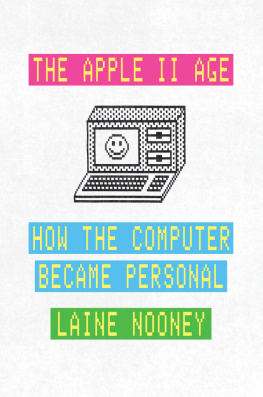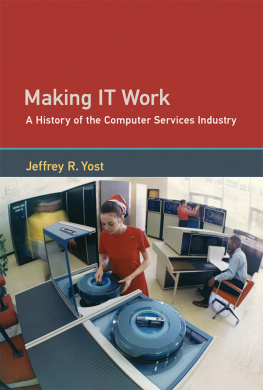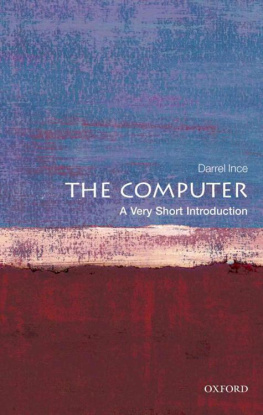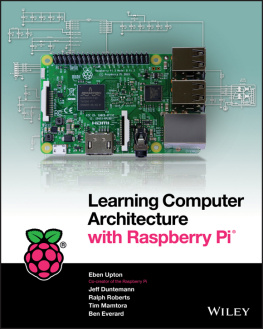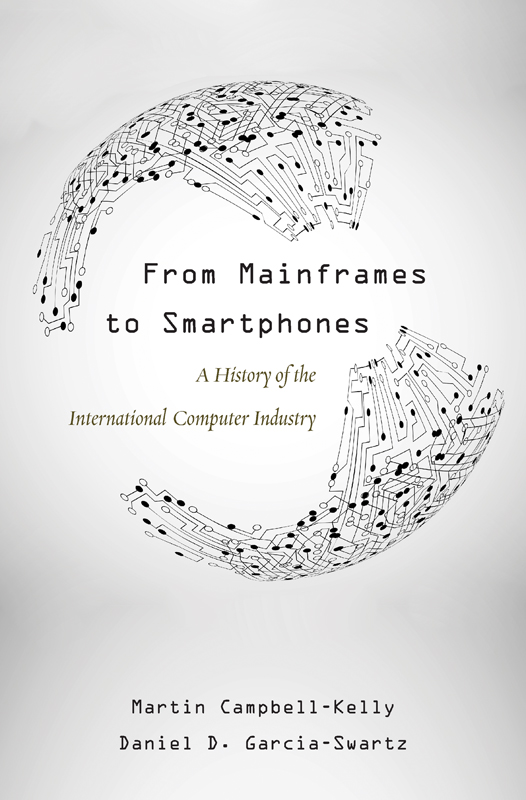Contents
Guide
MARTIN CAMPBELL-KELLY
DANIEL D. GARCIA-SWARTZ
FROM MAINFRAMES TO
SMARTPHONES
A History of the International
Computer Industry
HARVARD UNIVERSITY PRESS Cambridge, Massachusetts, and London, England 2015
Copyright 2015 by the President and Fellows of Harvard College
All rights reserved
Cover design: Eric Mulder
Cover art: Thinkstock
978-0-674-72906-3 (alk. paper)
978-0-674-28655-9 (EPUB)
978-0-674-28654-2 (MOBI)
The Library of Congress has cataloged the printed edition as follows:
Campbell-Kelly, Martin.
From mainframes to smartphones : a history of the international computer industry / Martin Campbell-Kelly and Daniel D. Garcia-Swartz.
pages cm
Includes bibliographical references and index.
1. Computer industryHistory. 2. Computer industryUnited StatesHistory. I. Garcia-Swartz, Daniel D., 1962 II. Title.
HD9696.2.A2C36 2015
338.4'7004dc23 2014039385
Contents
The aim of this book is to provide a compact and up-to-date business and economic history of the computer industry. The reader we have in mind is someone who wants to make a quick study of the computer industry. There is, in fact, no shortage of histories of the computer industry, and they fall into two broad classes. First, there are deeply researched and lengthy scholarly works dealing typically with a relatively narrow facet of the industry. Second, there are shorter and livelier treatments, but generally these are lightly documented or cover just a sliver of the industry. Because we know of no reasonably comprehensive treatment of the recent developments in the computer industry, we seek to fill what we and our editors view as a gap in the market: a book that is short, reliable, and includes an analysis of the industry through 2010 or so.
Although this book is primarily a business and economic history, the development of the computer industry is also a social and technical story that features many agents of change: human actors, corporations, and technologies. Among the human actors were the professional scientists, engineers, and mathematiciansand college kidswho made the key innovations, and the entrepreneurs who turned them into products. The computer industry was created by myriad firms of wildly distinct characters: from the staid office machine giants such as IBM and Remington Rand to college-dorm start-ups such as Dell Computer Corporation and Facebook. Above all, the relentless pace of technological improvement has transformed the industry, resulting not only in the revolution in miniature that saw the cost and power of electronics improve by multiple orders of magnitude but also in the development of complementary technologies such as storage devices, software, and telecommunications. We try to bring some of this background to our narrative, although our twin foci are primarily business and economic.
PERIODIZATION AND THEMES
There are many possible ways to organize the telling of the 60-year history of the computer industry, but we have opted for the most straightforward: a strictly chronological narrative. We have divided our story into four parts, each encompassing 15 years, beginning in 1950 and ending in 2010. By fortuitous historical accident, each one of these four periods constitutes a largely self-contained epoch in the evolution of the computer industry. The first period, from 1950 to 1965, saw the beginning of the commercial exploitation of the computer and the emergence of the first major players in the industry. The second period, spanning from 1965 to 1980, saw the arrival of the IBM System/360 computer family, which created the first information-technology standard and transformed the industry. The third period, from 1980 to 1995, saw the emergence of the personal computer, which led to another industry transformation. The final period we consider, covering the years 1995 to 2010, saw the industry transformed yet again, this time by the commercial development of the Internet. Although our periodization highlights these major transformations, we use the trends, themes, and continuities that defined the industry over time to thread our narrative. We detail these below.
One major theme in the development of the computer industry is the unstoppable miniaturization of computer platforms, a trend driven primarily by technological change in the field of electronics. The early mainframes were massive machines typically housed in dedicated spaces with powerful air-conditioning equipment. The first step toward making computers more compact came with the introduction of minicomputers and small business computers in the 1970s. Another step came with the dawn of the personal computer in the 1980s. In recent years further miniaturization has resulted in the proliferation of smartphones, which are in essence general-purpose computers with telephone capabilities.
A second theme in our book is the shifting core of the computer industry from hardware to software and services. Computer hardware has tended to become a commodity; only those firms able to successfully diversify into other markets have managed to remain significant players in the industry. No company provides a better example of this transformation than IBM, the firm that has stayed at the top of the industry for decades. Although by 1995 IBM may have been perceived as a computer hardware company, it was already obtaining almost half of its revenues from computer software and services. At the time of this writing, IBM derived just 17 percent of its revenues from hardware.
A third theme in the industry is the evolution of computers as systems. Information systems are collections of interconnected hardware and software components that work well with one another. In the early days of the industry, computer vendors supplied bundles of hardware, software, and services. During the 1960s independent firms entered the market to compete with computer manufacturers by supplying complements for computer processors. Plug-compatible manufacturers of peripherals, for example, thrived by supplying components that could be connected to IBM mainframes and beat IBMs peripherals in price-performance ratio. Later that decade, IBM started unbundling software from hardware, a decision that facilitated the development of a software market populated by numerous independent providers.
Manufacturers of computer processors have traditionally faced the choice of either supplying all the components of the system themselves or relying on third-party suppliers for at least some components. In the early days of System/360, IBM implemented a fully integrated model: it supplied all-inclusive systems designed and manufactured in-house. With the IBM PC, the company changed its approach radically: the PCs components were sourced from a variety of third-party vendors. In recent decades the process of vertical disintegration of PC production, driven by its modular nature, has deepened even further along geographic dimensions, with manufacturing of components shifting first to Asian countries such as Taiwan and later to China.
Computers are often described as both systems and platforms. System- or platform-type products are characterized by network effects, a topic that comes up often in our book. Network effects generally happen when additional users generate benefits for existing users. System- or platform-type products with just one type of user can only derive benefits from direct network effects: early adopters of computer mainframes, for example, benefited from a growing user base because, among other things, a growing base led to the formation of user groups that facilitated the exchange of technical information and software, which reduced costs for all participants.


